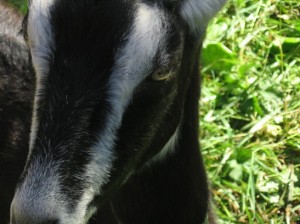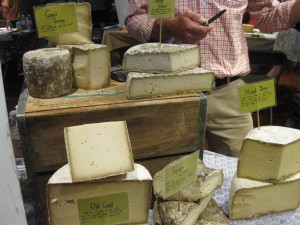Back to Basics: How Milk Becomes Cheese



We’re all familiar with author Cliff Fadiman’s delightful, witty, and pretty spot-on quote about cheese being milk’s leap toward immortality, but most of us are hardly familiar with the process by which that happens. If you’ve ever wondered to yourself “How does milk become cheese”, we’re here to help! We’re going back to basics for awhile here on the Cheese Department Blog, and this week, we’re going to review the base of the basics. (Please note: while we have some experience making cheese, we’re not scientists nor do we make cheese for a living. What follows is an overview of the general process of cheesemaking, created by people who love cheese (us) for those who love cheese (you)! Plenty of resources are available if you really want to get down to the nitty gritty of cheese. Our recommendation for a great place to start is Paul Kindstedt’s wonderfully informative book American Farmstead Cheese: The Complete Guide to Making and Selling Artisan Cheeses.)
There are astonishingly few ingredients required for most modern-day cheeses: milk, cultures (i.e. bacteria), coagulant (usually rennet), and salt. There you go: just four items that get mixed together. Sounds simple, right? Well, yes and no. Those four ingredients are combined, heated, pressed, and aged, but it’s so much more than that: it’s chemistry, art, math, intuition, and lots & lots of practice.
So what’s actually going on here? What cheesemakers do is use cultures and coagulant to separate out the fats and proteins of the milk, which they want to keep, from the water and sugars, which they want to keep out, and this generally happens in eight distinguishable steps…
STEP ONE: Specially-chosen cultures are added to warm milk in order to turn the milk sugar called lactose into lactic acid. Why do this? Because it allows the maker to control the fermentation of the rest of the process. After all, cheese, like beer, wine, bread, and kimchi, is a delicious fermented product.
After the mixture of the milk and cultures gets to the right temperature, you get to STEP TWO: Rennet is added to make that mixture coagulate so that it becomes almost custard-like in consistency. How does that happen? The rennet changes the structure of the milk’s protein, causing it to entrap the milk’s fat and in a sense protect it from the water/sugar portion of the milk. It’s like the fat and protein are rubbing against the water and sugar, but not exactly mixing with them.
When the custard-like substance hits the right consistency, you’re on to STEP THREE: The fat-protein portions are actively separated from the water-sugar portions by cutting the coagulated mass all up, resulting in very distinct curds (the fat & protein) and whey (the water & sugar/acid). Remember Little Miss Moppet? She was eating cheese at this moment of its life. If you looked into a cheese vat at this point, it would look like fluffy white blobs of popcorn or rice floating around in liquid.
And now, STEP FOUR: The curds are cooked in this whey bath at a specific rate until they reach the desired temperature, firmness, and pH, and during this time whey gets released from the curds. It’s important to note here that although this is a critical step for some cheeses, others- such as Brie and Camembert- are simply held at the initial temperature for awhile.
When those curds are ready, it’s time for STEP FIVE: The curds are permanently separated from whey either through draining the whey straight out of the vat, leaving the curds behind, or scooping both curds and whey into special draining forms called molds. Discarding all that whey might seem like such a waste, but remember that this has been the goal all along: keeping the fat and protein bits and getting rid of the water and sugar bits. If you’re still concerned, don’t worry: sometimes whey is used to make ricotta and sometimes it’s fed to pigs, so non-vegetarians should keep an eye out for ‘whey-fed’ pork products because they are delicious.
At this point, those curds are sitting around in a lovely pile of curdy goodness, but to become real wheels of cheese they have to fuse together into a solid mass of a specific shape, and that’s exactly what happens in STEP SIX: The curds get knitted together and compacted through the process of pressing, turning, or even simple gravity. If pressing is required, this can be achieved using mechanical presses and weights (easy!) or straight up cheesemaker muscles (hardcore!) One is not better than the other, of course, and different cheeses have different optimal methods. No matter how it’s accomplished, what results is a solid, recognizable wheel of cheese.
At this point, salt-lovers might be wondering, “What about the salt? When does that come in?” Well, this last ingredient usually comes in here at STEP SEVEN: Salt is sometimes added to the cheese before the pressing (like with Cheddar) but most often it happens afterward, either by the straight application of dry salt (like with Brie) or by soaking wheels in a salt brine (which happens with many, many cheeses). Salt has numerous important functions in cheesemaking, including moisture control, rind formation, texture improvement, fermentation inhibition, microbe regulation, and flavor development & enhancement. See what we mean? Important stuff, salt.
Only one step remains and that is STEP EIGHT: Any special procedure which has to occur for particular aspects of a cheese to develop during its aging. For example, blue cheeses must be pierced before aging so that the blue mold can grow inside, bloomy rind cheeses must be sprayed with specific mold spores so that the rind becomes bloomy, and washed-rind cheeses must be rubbed with whatever washing liquid is chosen. Many cheeses, however, skip this step entirely and are taken directly to age and ripen until ready.
And there you have it! Four ingredients, eight steps, and a whole lot of science and art later, you have cheese! Not just one cheese, of course: the miracle of this process is that variations on those ingredients and steps results in a mind-blowing myriad of ever-growing varieties of delicious cheese. We just love that. We just love cheese! Speaking of which, perhaps we should include a last and equally important STEP NINE here: The cheese is eaten and enjoyed.




